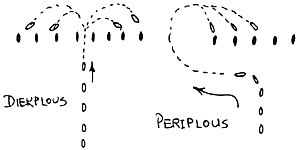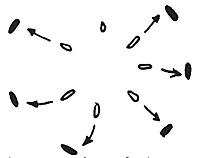EDITOR'S NOTE
Below is an interesting input from Tom Elsworth who indicates he's in the process of generating a set of rules for ship to ship warfare in the ancients era...
- "I am going to use 1:1250 models, probably about 20 to
30 on each side. The main problems seem to be how to deal
with the fatigue of the crew, and a move sequence which
really flows without any 'gotchas'.
Any records can be kept by squadron of 5 or 6 craft to reduce the paperwork; the quality of the craft within a squadron would be uniform. It makes a good naval game because it makes sense to use islands and shores, and it's easy to integrate land action."
Trireme
1. Properly called "TRIERES", but normally known by the latin version, the trireme was the mainstay of naval warfare in the Mediterranean from about 600 BC until about 200 BC. After then, it declined in importance as bigger and bigger craft took over. I find this latter period less interesting because we lose the importance of manoever, oarsmanship and the consumate seamanship involved in trireme warfare.
2. The Craft
- a. all in length approx 40 metres
b. beam including oars approx 12 metres
c. crew 10 marine hoplites, 4 marine archers, 186 crew and officers. The number of soldiers carried could be increased to 40 at some cost in stability and speed.
3. Organisation
- a. Each ship commanded by a TRIERARCH
b. Up to 15 ships form a squadron under a NAUARCH
c. Several squadrons form a fleet under a STRATEGOS
4. Operational Parameters
a. Triremes were categorized as FAST or SLOW
Fast ships were
- (i)specially built and expensiv
or (ii)recently relaunched after drying out on the beach,
or (iii) both.
Fast ships of Type (i) would be 20% faster all around, while Types (ii) and (iii) would be able to maintain ram speed for 20% longer but would be 20% slower in the turn.
+b. The oarsmen were of critical importance as no sails are carried into battle except for a small station keeping or "boat" sail. The key factors were:
- Training: for skill in station keeping and in manoever
Endurance
Achievable final ram speed
Fatigue: a tired crew would seriously effect all parameters by up to 50%
Morale: Very critical as nothing can prevent a trireme that wants to, from running away downwind. Most important factor is the nearby presence of a friendly shoreline.
Weather: Important because more than a slight breeze makes rowing very difficult for any but the most highly trained crew. Any sort of bad weather is serious because of the low bulwarks.
c. Movement
- Cruising under oars: 8 knots
Cruising under sail, (main): 6 knots
Cruising under sail, (boat only): 4 knots
Maximum ram speed: 10 knots
The turning circle depends upon forward speed, training, fatigue, and whether the ship is fast or slow. Ideally, while having no forward way, a trireme can turn on its heel.
 5. Action
5. Action
a. The main weapon is the ram; the archers and the hoplites are only used in combined operations or if the rammer is unable to withdraw.
b. There is also the danger of the ram being torn off; this chance increases inproportion to the relative lateral movement of the target.
The normal procedure was for the attacker to turn in the same direction as the target at the last moment.
c. Triremes do not sink when holed... they only swamp, tending to drift downwind or with the current. They were usually towed away for repair by the victorious side.
 d. The main tactics were the DIEKPLOUS, or breakthrough, and
the PERIPLOUS, or flanking, move:
d. The main tactics were the DIEKPLOUS, or breakthrough, and
the PERIPLOUS, or flanking, move:
If all else is equal, it is the faster fleet which can carry
out these tactics.
 e. Normally, fleets deployed in line abreast for mutual
defence, but very skilled fleets could form circle.
e. Normally, fleets deployed in line abreast for mutual
defence, but very skilled fleets could form circle.
When the attacker had tired rowing futilely around the circle, the defender burst out in all directions and attacked at an advantage.
f. The minor tactics of the ram involved an attempt to move into position to charge the target amidships. A less skilled or tired or slow ship might not be able to do this and might try a beak-to-beak ram in an effort to shear off enemy oars... but this was a dangerous tactic agianst a skilled enemy.
6. I have not written any rules yet, but propose to work on a 1:1 figure scale, and, as previously mentioned, a 1:1250 grand scale with a 2 1/2 minute bound. This gives a speed of one knot approximating to a 50mm move. No doubt a card movement system could be derived.
Back to PW Review June 1987 Table of Contents
Back to PW Review List of Issues
Back to MagWeb Master Magazine List
© Copyright 1987 Wally Simon
This article appears in MagWeb (Magazine Web) on the Internet World Wide Web.
Other military history articles and gaming articles are available at http://www.magweb.com